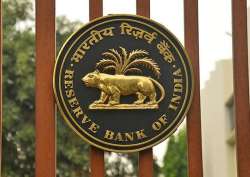RBI’s revised NPA resolution framework long-term positive: Report
The report states that the new framework has the potential to bring about a big change in the approach of banks to monitor their exposures and resolution of non-performing assets (NPAs).

The Reserve Bank's revised framework for quicker and time-bound resolution of stressed assets is a long-term positive for banks, says a report.
The report states that the new framework has the potential to bring about a big change in the approach of banks to monitor their exposures and resolution of non-performing assets (NPAs).
"The streamlining of the NPA resolution process affords simplicity, timeliness and credibility, and is long-term positive for the banking sector," Krishnan Sitaraman, a senior director at Crisil, said in the report today.
The apex bank in a dramatic move on Monday had discontinued programmes for banks to restructure their defaulted loans such as corporate debt restructuring (CDR), sustainable structuring of stressed assets (S4A), strategic debt restructuring (SDR), among others, and made the Insolvency and Bankruptcy Code as the main tool to deal with defaulters.
Lenders will now have to work out a resolution plan for defaults within 180 days, failing which the account would be referred to the bankruptcy courts.
The agency feels that the upshot of the strong statement of intent by RBI will be structural streamlining, standardising and harmonising of the resolution process leading to greater transparency, credibility and efficiency.
The central bank has also asked lenders to report credit information, including classification of an account as special mention account (SMA) to the Central Repository of Information on Large Credits (CRILC) on all borrowers having an aggregate exposure of Rs 5 crore and above.
The lenders will have to report to CRILC, all borrower entities in default on a weekly basis, at the close of business on every Friday, or the preceding working day if Friday happens to be a holiday. The first such weekly report shall be submitted for the week ending February 23, 2018.
The central bank has also asked all lenders to put in place board-approved policies, with timeliness, for resolution of stressed assets under the new framework.
"By mandating weekly information on large delinquent accounts, by directing that a resolution plan be scripted immediately after default, and by setting stringent timelines for referring an account to the Insolvency and Bankruptcy Code process, the RBI is establishing an ecosystem where NPAs would get recognised on time and their resolutions are structurally quicker than before," the report said.
The RBI also said under the new framework the resolution plan which may involve restructuring, change in ownership in respect of 'large' accounts, will require independent credit evaluation of the residual debt by credit rating agencies (CRAs) authorised by it.
Independent credit evaluation of the residual debt in resolution plans, and minimum investment grade rating for any upgrade of NPAs, will improve investor and other stakeholder confidence over the long term, said Crisil.
According to the agency, in recent years, several steps such as CDR SDR, S4A were conceived to resolve the stressed assets situation but to limited success.
"The RBI move has come at the right hour because the asset quality pressures are near their peak and it will improve the ability of banks to transit to the new regime," the report said.
